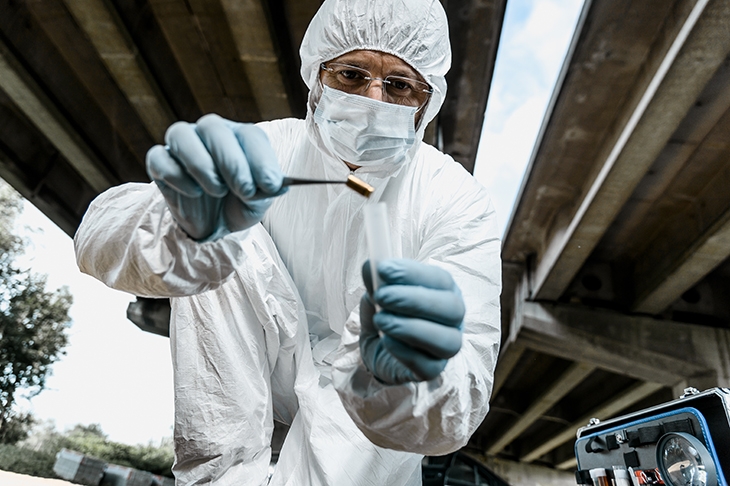When the 24-year-old Angela Gallop started working at the Home Office forensic science service, her boss lost no time in telling her that ‘a woman’s place is in the home — literally, at the kitchen sink’. Many years later, having contributed to solving some of the UK’s highest profile criminal cases, Gallop may have remembered those words with a smile as she mopped the office floor. This was no display of domesticity; she was in pursuit of a murderer.
A man had been accused by his wife of killing his boss. The wife said that the spatters of blood on the wall of the fast-food café where they worked had resulted from her husband’s violent kicks and punches to the owner’s body. But the defendant claimed that the blood streaks were his attempts to mop up the mess where his wife had carried out the murder. Professor Gallop thought to re-create the scene with old transplant blood she’d acquired from the lab. The pattern left behind by her mop’s strings closely resembled the stains on the wall at the crime scene. Perhaps the husband was telling the truth after all. Through these ingenious reenactments, Gallop has demonstrated time and again that being the country’s top forensic scientist is a place comfortably enjoyed by a woman.
Things could have been so different. Her PhD at Oxford was on sea slugs. But frustrated with the low stakes of her work, she swapped the creatures’ slimy trails for criminal traces. Her forensic apprenticeship in a brusque male culture helped to ‘disengage the emotional side of my mind and focus on whatever scientific puzzle I was trying to solve’. Yet when she held up the tiny sweatshirt of a two-year-old boy, her stoicism was sorely tested. James Bulger, Stephen Lawrence, Dr David Kelly, the Yorkshire Ripper, Damilola Taylor, Princess Diana: Gallop talks her readers through each of these cases and the forensic details behind the headlines.
When the Dogs Don’t Bark is a fascinating memoir of a scientist’s career, but also the history of a field’s technological transformation. In the 1970s, forensic chemistry was the sexy science for solving crime which focused on poisons and drugs (also a time when health and safety regulations for handling chemicals were non-existent). Meanwhile, forensic biology contributed the relatively crude tools of blood-typing and body-fluid analysis. The number of false positives was alarming; scientists ‘must have been responsible for wrecking some perfectly good marriages’.
The advent of DNA profiling in 1984 ‘transformed the strength of the link between individual people and traces of saliva, semen, blood and even skin flakes’. With this intricacy came new standards of cleanliness for investigators because they could so easily contaminate the evidence. The national DNA database opened in 1995, archiving the profiles of thousands of arrested suspects. Blood-pattern analysis has characterised the different flicks, spurts, smudges, drips and clots that result from gunshots, knife wounds and passive bleeding. CCTV, laptops and mobile phones have further stretched the remit of forensic work. But whether bodily, material or cybernetic, Locard’s Exchange Principle still holds: every contact leaves a trace.
Gallop welcomes the field’s innovations, but remains rightly sceptical. The key skills of forensics risk being undervalued: precision, determination and imagination. Fabric strands, footprints, handwriting and cigarette butts can still be those ‘golden nuggets’ that resolve crimes, and the government must ensure this breadth of investigation. When Gallop witnessed forensic rationing, she set up her own company, Forensic Access, which provides evidence to defence teams as well as just the prosecution.
As a cost-cutting measure, scientists are increasingly prevented from visiting crime scenes and are sent fewer objects to analyse. It often falls to the police to provide ‘impartial’ forensic science evidence that supports their prosecutions. It’s a false economy. Gallop explains that when she’s hanging around a crime scene, seemingly doing not much at all, this is fruitful time when she’s mentally rehearsing what might have happened. Miscarriages of justice occur when cases are not raked over carefully or cleverly enough. As her book’s title reminds us, absence of evidence can’t be assumed to be evidence of absence.
In the wrong hands, When the Dogs Don’t Bark might have become yet another ‘how to’ guide about thinking logically and avoiding cognitive biases. It’s much more than that. Forensic science and criminal justice, like non-fiction, require skilful storytellers to make a sequence of facts speak loudly and truthfully. Gallop mounts a powerful case that the rigour of our judicial system is worth defending, because anyone, even you, ‘might come up against it in an immediate and personal way’.






Comments